Explore Murshidabad
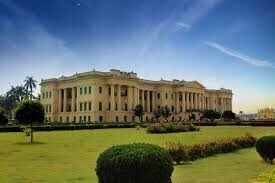
The Hazarduari Palace
Hazarduari Palace in Murshidabad is the place where history speaks for itself. Combining the 19th-century famous architecture, impressive interior, and rich history. The palace represents both European and Indian style with a central courtyard surrounded by two-storey buildings.The Hazarduari Palace houses an enormous collection of artefacts and treasured exhibits that include ancient pieces of furniture, paintings, and ornaments. In turn, the museum reveals the richness of the Nawabs’ lives and the rich cultural heritage of the region. Visiting Hazarduari Palace opens doors to the rich history and architectural wonders of West Bengal.
Motijheel Park
Motijheel is Explore Murshidabad’s rich history! Visit Hazarduari Palace, Katra Masjid, Motijheel, and more. Discover Nawabi-era splendour and architectural wonders. Another place in Murshidabad, a 350-acre oxbow lake in India, represents a milestone in the history of the nation, being the birthplace of British rule. Its origin issues from the abandoned bed of the Bhagirathi River. Its name, “Motijheel,” was derived from the extensive pearl cultivation during the Nawabi era. The famous golden-tinted pearls extracted from the Unio margaritifera species are among the best in the world and have marked Motijheel as among the most important places of the pearl trade.
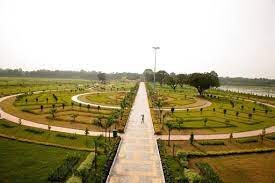

Katra Masjid
Located approximately a mile northeast of Murshidabad town and just 3 kilometres from Murshidabad Railway Station, Katra Masjid is a significant historic landmark. Constructed by Nawab Murshid Quli Khan, this impressive mosque was built in just one year by the talented architect Murad Farash. This place must be on your bucket list in the Murshidabad tour.
Elevated on a 54-meter-high square plinth, the brick-built Katra Masjid is surrounded by a row of double-storied domed cells. These cells form a cloister around the spacious courtyard in front, creating a serene and contemplative atmosphere.
Kathgola Gardens
Very nicely maintained Heritage property in Murshidabad. Many historical artifacts and unique construction materials concept used while designing the internal staircase. One of the old tourist palaces to visit in Murshidabad. Very finely built on a vast land with a variety of trees and water bodies present. There is also a Tunnel present. Full of memorabilia and artefacts of lost times and antiques. Kathgola is one of the local places in Murshidabad city, which was a former capital for Bengal, Bihar, and Orissa under the rule of Nawabs of Bengal.
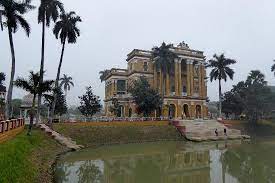
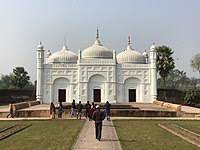
Khosh Bagh
Khosh Bagh is located on the opposite bank of the Bhagirathi. The tomb of Nawab Alivardi Khan, Alivardi’s Mother, Siraj-ud-Doula, and his wife Lutfannesha, and other members of the Nawab family lived here. The Khosh Bagh cemetery is built over 7.65 acres of land.
Jahan Kosha Cannon
Motijheel stands witness to a remarkable turning point in Indian history, the beginning of the fall of British rule in India. The base of Motijheel is a 350-acre oxbow lake developed out of an abandoned bed of the Bhagirathi River, which got its name from large-scale pearl cultivation during the Nawabi era. The Jheel was famous for rearing golden-tinted pearls extracted from the union margaritifera species.
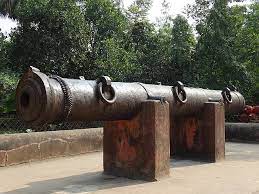
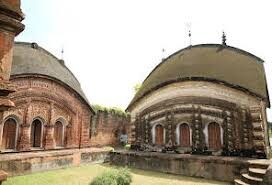
Char Bangla Temple
Char Bangla Mandiralaya at Baranagar is one of the most picturesque and interesting temple complexes built in Bengal for centuries. This temple is located on the bank of the Bhagirathi River and can be reached by a short ride upstream from Azimganj Sadarghat, which falls on the opposite bank. Some of the most famous temples that have survived the erosion of time are the Jor Bangla temple also known as Gangeswar Temple, Ek Bangla Panchanan Shiva Temple, Bhabaniswar Temple, Raj Rajeswari Temple and of course, Char Bangla Temple.
House Of Jagath Seth
House of Jagat Seth Museum contains personal possessions of Jagat Seth and his family, including coins of the bygone era, muslin and other extravagant clothes, Banarasi sarees embroidered with gold and silver threads.

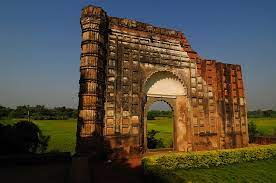
TOMB OF AZIMUNNISA BEGUM
Azimunnisa Begum’s tomb is one of the oldest visiting places in Murshidabad. According to the list of Monuments of National Importance in West Bengal, this tomb is an ASI listed Monument.
Nasipur Palace
Kiriteswari is one of the oldest temples situated in the Murshidabad district under the name Kirtikona Village. It is one of the 51 peeths. Sati peeth is one among them.
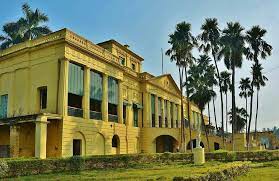
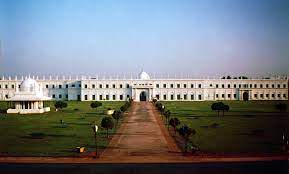
Imambara
Nizamat Imambara located in Murshidabad, India. The current Nizamat Imambara was established in 1847 AD by Nawab Mansur Ali Khan. And Nawab Siraj ud-Daula constructed the old one which was destroyed due to fires of 1842 and 1846.
The old Imambar, which was constructed by Nawab Siraj ud-Daulah, was gutted due to the fires of 1842 and 1846.
Kiriteswari Temple
Kiriteswari Temple is situated in Kiritkona village under the Nabagram in Murshidabad district in the state of West Bengal. This is one of the Sati peeth among the 51 peeths.
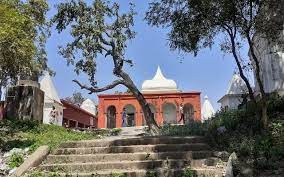

Jalangi River
The Jalangi River forms the arm or distributary of the Ganges River emerging from the Ganges or Padma near Bhagawangola in Murshidabad district of West Bengal. The length of the river is 233 km, and it falls into Bhagirathi-Hooghly near Nabadwip in West Bengal.
Motijheel Mosque and Cemetery
Motijheel mosque and cemetery have a very important place in the history of Murshidabad. Mawazesh Md. Khan, son-in-law of Nawab Ali Vardi Khan and subedar of then Bengal, Bihar and Odisha and Ekramoddulla, younger brother of Nawab Sirajuddullah, are buried here. Motijheel is a horseshoe-shaped lake. And in a palace adjoining it, which now lies in ruins, was the home of Warren Hastings when he became the political president at the Durbar of the Nawab Nazim. The tombs are located east of the mosque.


Tomb of Siraj-ud-Daulah
The contribution of Nawab Siraj-ud-Daulah to save the independence of Bengal is worth remembering on this great festival of independence. Visiting the tomb of Nawab Sirajuddaula lying on the west bank of the Hooghly river in Khushbagh was the purpose, along with getting familiar with the historical buildings and monuments situated in Murshidabad, West Bengal.
Old Cossimbazar (Berhampore) Palace
It was in the 17th century that Cossimbazar developed into a port city, and recorded history dates back to pre-emergent Murshidabad. By the middle of the century, the Dutch, the French, and the British had already set up their trading posts, commonly known as factories in Cossimbazar. Its famous silk cloth drew traders from far and wide, and this small village became an international trading centre.
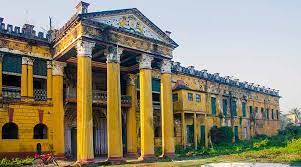
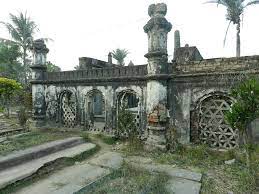
Jafarganj Cemetery
Jafarganj Cemetery was built by Mir Jafar over an area of 3.51 acres within an enclosure of waved walls, about half a mile north of the Nizamat Fort Campus and inside the campus of Namak Haram Deorhi. It houses the graves of late Nawabs of Bengal belonging to the Najafi dynasty, starting from Mir Jafar and their family members, while Khushbagh was built by Nawab Alivardi Khan, which houses the graves of the Nawabs of Bengal belonging to the Afshar dynasty and their family members. Presently, this graveyard is controlled and maintained by the Archaeological Survey of India.
Wasef Manzil
The beauty is the same with the palace, though small. Besides the architectural beauties, the marble statues it has will surely catch your attention. There was an artificial hill along with the artificial landscape at the side of the palace, which were all destroyed during the earthquakes of 1867, and most of the palace.
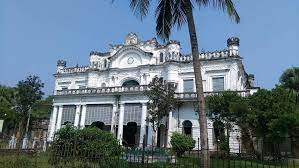
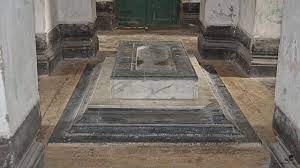
Tomb of Alivardi Khan
The tomb of Alivardi Khan is a prominent cemetery situated on the reverse bank of the Bhagirathi river of Murshidabad in West Bengal. It is also referred to as Khushbagh or Garden of Happiness. It interprets Alivardi Khan, who was the Nawab of Bengal. Besides the burial of Alivardi Khan, it is also known for the burial of his mother, grandson who was also a nawab by the name of Nawab Siraj-ud-Dulah and his grandson’s wife Luff-un-nisa. Essentially, the Tomb of Alivardi Khan houses the graves of rulers of Bengal belonging to the Afsar family.
Footi Mosque
Futi Mosque is a mosque in the city of Kumarpur, India, which was constructed by Nawab Sarfaraz Khan in 1740 AD. The old Futi Masjid is one of the largest mosques in the town of Kumarpur and Murshidabad. It is around three quarters of a mile away from the magnificent and famous Hazarduari Palace. This magnificent mosque is 135 feet long and 38 feet broad.
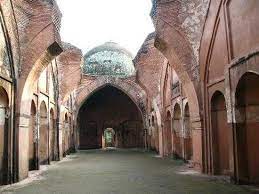
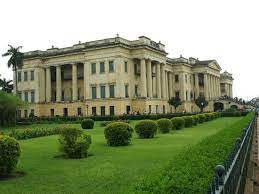
Azimganj
One of the most beautiful examples of Bengal Temple architecture is the Char Bangla Temple at Baranagar in Azimganj. These temples were erected during the 18th century, with the patronage of Rani Bhabani of Natore, now Bangladesh.
Bhavaniswar Mandir
The Bhavaniswar Mandir at Baranagar was built in 1755 by Tarasundari, daughter of Rani Bhabani. It is the tallest lime and mortar temple at Baranagar. According to Shyamal Chaterji, researcher on Hindu iconography, the “inverted lotus-like dome of this 18 M tall temple and a circular corridor around the inner sanctum are noteworthy features. Human figures on the outer facade are average.
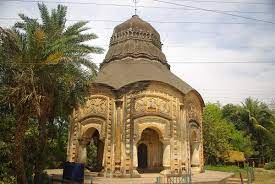
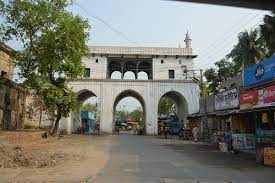
Tripolia Gate
Tripolia Gate is in Murshidabad. Before you visit Murshidabad, make your trip planning easy with our Murshidabad travel itinerary to discover the best that Murshidabad has to offer you. The easy-to-use Murshidabad trip planner is here to serve you.
Yellow Mosque
Murshidabad traveler area has innumerable unbelievable vacationer places like the Yellow Mosque and other spots to visit in Murshidabad. Yellow Mosque is likewise one of the celebrated places in Murshidabad to visit for occasions with your family or friends. Murshidabad climate and temperature in Murshidabad offers great and ideal comfortable conditions to travellers to make a trip to the best places to visit in Murshidabad at all times.


Nimak Haram Deori
Nimak Haram Deori is the principal entry door to the palace of Mir Jafar, the betrayer’s palace Jafargunj. It lies at a distance of just 1 Kilometer north of the magnificent Hazarduari. Visitors cannot enter into the palace as it is well guarded. This palace stands as a memorial to the darkest hour in Bengal’s history as Nawab Siraj-ud-Daulah was killed here in an act of betrayal. This killing was decisive for colonization in Bengal and India.

Dutch Cemetery
The Dutch Cemetery is located next to the Cossimbazar railway station at Kalkapur where the Dutch owned huge factories in the year 1666 AD were based. The grandeur of the Dutch has been ruined and small tombs of 43 in number remain to this day. Most of the monuments were built between 1721 and 1792 AD. The oldest monument at the Dutch cemetery belongs to Daniel van der Muyl who died in 1721. Most of the monuments are pyramidal in shape with cenotaphs mentioning the names.
